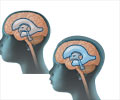If this method can be developed for clinical use, it will be a boon, since making the brain vibrate is quite painful at the moment.

One of the study authors Stefan Catheline from French Institute of Health and Medical Research (Inserm) said, "Alzheimer's disease, epilepsy, multiple sclerosis and hydrocephalus involve changes in the stiffness of the brain tissues. This new technique allows their detection, and could be used to avoid brain biopsies."
This palpation examination has been supplemented or replaced by modern techniques that give the physician an indication of the elasticity of a biological tissue. They are based on the generation and detection of waves that propagate through the body at varying speeds depending on the stiffness of the organs. The stiffer the tissue, the slower the wave propagation, and vice versa.
However, this method cannot be applied to the brain, which is doubly protected by the cranium and cerebrospinal fluid. In this study,the researchers team used MRI to detect natural shear waves in the brain using computational techniques borrowed from seismologists and known as 'noise correlation'. In this way, the team was able to build images of the brain's elasticity.
Catheline said, "If this method can be developed for clinical use, it will be a boon for both the patient and the physician, since making the brain vibrate is quite painful at the moment. Of course, this method will be complementary to those that already exist, and the future is in a multimodal medical diagnosis."
The study was published in the PNAS.
Advertisement















